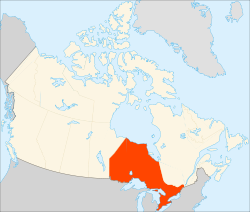The Ontario Portal


Ontario (/ɒnˈtɛərioʊ/ ⓘ on-TAIR-ee-oh; French: [ɔ̃taʁjo]) is the southernmost province of Canada. Located in Central Canada, Ontario is the country's most populous province. As of the 2021 Canadian census, it is home to 38.5 percent of the country's population, and is the second-largest province by total area (after Quebec). Ontario is Canada's fourth-largest jurisdiction in total area of all the Canadian provinces and territories. It is home to the nation's capital, Ottawa, and its most populous city, Toronto, which is Ontario's provincial capital.
Ontario is bordered by the province of Manitoba to the west, Hudson Bay and James Bay to the north, and Quebec to the east and northeast. To the south, it is bordered by the U.S. states of (from west to east) Minnesota, Michigan, Ohio, Pennsylvania, and New York. Almost all of Ontario's 2,700 km (1,700 mi) border with the United States follows rivers and lakes: from the westerly Lake of the Woods, eastward along the major rivers and lakes of the Great Lakes/Saint Lawrence River drainage system. There is only about 1 km (5⁄8 mi) of actual land border, made up of portages including Height of Land Portage on the Minnesota border.
The great majority of Ontario's population and arable land is in Southern Ontario, and while agriculture remains a significant industry, the region's economy depends highly on manufacturing. In contrast, Northern Ontario is sparsely populated with cold winters and heavy forestation, with mining and forestry making up the region's major industries. (Full article...)
Selected article -
The McLaughlin Planetarium is a former working planetarium whose building occupies a space immediately to the south of the Royal Ontario Museum in Toronto, at 100 Queen's Park. Founded by a grant from philanthropist Colonel R. Samuel McLaughlin, the facility was opened to the public on October 26, 1968. It had, for its time, a state-of-the-art electro-mechanical Zeiss planetarium projector that was used to project regular themed shows about the stars, planets, and cosmology for visitors. By the 1980s the planetarium's sound-system and domed ceiling were used to display dazzling music-themed laser-light shows. The lower levels of the planetarium contained a gallery called the "Astrocentre" that featured space-related exhibits, related artifacts on the history of astronomy and was also home of the world's first commercial Stellarium
Starting in 1978, there was a decline in attendance that lasted for four years while major construction was being undertaken at its sibling institution, the adjacent Royal Ontario Museum. This work also entailed the demolition of part of the planetarium's facilities. Though attendance picked up when the museum reopened in 1984, the planetarium was forced to close on November 5, 1995, due to provincial budget cuts to the museum. The planetarium's exhibits, artifacts and theatre facilities were subsequently dismantled and dispersed. For a brief period it housed the Children's Own Museum. It is now used solely for offices and as a storage facility for the museum.
Early in 2009, the R.O.M. announced that it had sold the building and site to the University of Toronto, which plans to demolish the existing building to make way for additional facilities. In September 2014, the university announced preliminary plans for new facilities to be built on the site. (Full article...)General images
Surrounding areas
Selected biography -
Ralph Harvey Jackson (January 17, 1911 – June 25, 1966) was a Canadian professional ice hockey player. Jackson played 15 National Hockey League (NHL) seasons between 1929 and 1944 for the Toronto Maple Leafs, New York Americans, and Boston Bruins. He was a member of the Maple Leafs' famed Kid Line with Joe Primeau and Charlie Conacher, one of the early NHL's dominant scoring trios. Jackson led the league in scoring in 1931–32 and was a member of Toronto's 1932 Stanley Cup championship team. He was named to five NHL All-Star teams and played in three benefit All-Star Games, including the Ace Bailey Benefit Game, the first All-Star contest in NHL history.
Off the ice, Jackson was well-known for his high-spending lifestyle and drinking habit that prompted his trade from Toronto to New York in 1939. He was remembered as one of hockey's tragic figures following his retirement, as he struggled with alcoholism and financial difficulty. In the 1960s, Jackson was a figure of controversy within the Hockey Hall of Fame selection committee, as the Hall used his lifestyle and personal problems to block his induction. He finally earned a place in the Hall of Fame in 1971, five years after his death. Jackson is also an honoured member of Canada's Sports Hall of Fame, which he was inducted into in 1975. He was the brother of fellow NHL player Art Jackson. (Full article...)Selected image
Did you know? -
- ... that nearly every person in Val Gagné, Ontario, died in the 1916 Matheson Fire, and the settlement was renamed to honour the heroic efforts of the parish priest?
Related projects and portals
Topics
Categories
Things you can do
- Help expand stub articles: There are numerous stub articles relating to Ontario. You can help by expanding them. See Ontario stubs for a list. Also, for geographical (places) stubs, refer to:
- Eastern Ontario: Eastern Ontario geography stubs
- Toronto: Toronto geography stubs
- Ottawa: Ottawa stubs - All stubs relating to Ottawa in general
- Northern Ontario: Northern Ontario geography stubs
- Western Ontario: Western Ontario geography stubs
- Golden Horseshoe: Golden Horseshoe geography stubs
Associated Wikimedia -
The following Wikimedia Foundation sister projects provide more on this subject:
-
 Commons
Commons
Free media repository -
 Wikibooks
Wikibooks
Free textbooks and manuals -
 Wikidata
Wikidata
Free knowledge base -
 Wikinews
Wikinews
Free-content news -
 Wikiquote
Wikiquote
Collection of quotations -
 Wikisource
Wikisource
Free-content library -
 Wikiversity
Wikiversity
Free learning tools -
 Wikivoyage
Wikivoyage
Free travel guide -
 Wiktionary
Wiktionary
Dictionary and thesaurus
-

-

-

-

-
Random portal


























